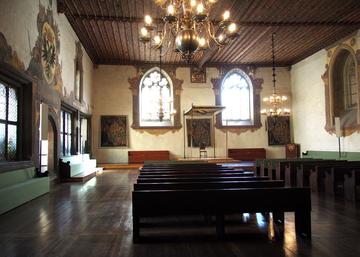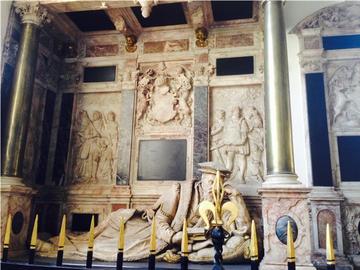Parliamentary Humanism: The History of Parliaments as The History of Ideas
Ideas, politics and institutions tend to go in separate intellectual boxes. Historians of politics bury themselves in the exciting histoire événementielle of national politics; historians of ideas go for the concepts and questions that loom over their arguments. Sometimes they mix them together, dipping into ideologies or sampling context. Institutional historians seem a sort of poor relation: smelling of archives and pipe tobacco, conducting a minute scrutiny of the stage, rather than what was actually going on upon it, or the arguments among the critics about whether it was any good.

The House of Commons in Session, Oil painting by Peter Tillemans c. 1710, © Parliamentary Art Collection, WOA 2737.
Should this be so? It certainly hasn’t always been true. Indeed, the Whig tradition in England recognised little difference between them, for to its exponents the big ideas were embodied in institutional politics. Politics was about power expressed through constitutions, about freedom embedded in parliament, and about how ‘parliament’, acting somehow corporately, met threats to curtail it in a series of confrontations with Tudor, Stuart and Georgian kings. But the reaction in Britain against whiggism and its favourite tropes in the 1970s and 1980s made parliaments and this sort of constitutional history historiographically unfashionable, in the same way as the contemporary reaction against a series of canonical texts in the history of political thought made a ‘great men’ approach to the subject feel as dead as a doornail. As the history of political thought spread into a broader history of intellectuals thinking more or less politically and the history of politics moved, through several turns, to the less formal arenas of print culture, the public sphere or the agency of those excluded from mainstream engagement with the institution, institutions themselves felt unexciting and unloved.
Perhaps the separation of these spheres has not been quite so true in other countries in Europe, where ‘parliamentarism’ marked the elevation of the institution to an idea, even an ideal, and politicians and political theorists like the Abbe Sièyes, Benjamin Constant and Francois Guizot grappled with the relationship between representative and parliamentary institutions, democracy and monarchy; and German political scientists like von Gneist, Josef Redlich and Weber struggled to understand how history, procedure or sociology influenced their effectiveness. William Selinger has recently explored this world in Parliamentarism, bringing a welcome new recognition to parliaments as theory. But despite the greater interest in these matters abroad, they can still seem like an English, Whiggish obsession. While welcoming the transnational turn in the Anglophone history of political thought, Peter Ghosh in a blog for this Centre suggested that while ‘the term “parliamentarism” was a Continental neologism’, it was ‘designed to convey an alien English peculiarity.’ Of course it is true that the pattern that Sièyes and Constant had in mind, initially at least, was the mad bear-garden over the channel, and the context for the invention of ‘parliamentarism’ was the post-1789 conceptual difficulty of preserving an aristocratic style of government within an increasingly democratic framework. And yet the concept was freighted with a much broader baggage of ideas about national political assemblies, which, if it had survived in Britain, had once existed rather more widely across Europe.

The meeting place of the Diet in the Alten Rathaus in Regensburg, photographed in 2016 By Hajotthu, CC BY-SA 3.0.
That baggage has indeed been widely investigated by the historians of political thought. Always, though, it is investigated as individual abstract ideas: sovereignty, liberty, representation; aristocracy; mixed government; resistance theory; civic humanism; republicanism and so on. Parliaments themselves are treated simply as a vehicle, a mere mechanism, their significance as an idea often boiled down just to the notion of representation. But most of these ideas are embodied, in large part, at least, in the idea and practice of political assembly. Political assemblies defined communities as unified political entities through collective (if symbolised) presence. They stood for the way in which those communities are shielded from the power of a ruler by a set of corporate liberties enshrined in laws or charters. They signified the ability of some people, whether an aristocracy or a broader elite, to contribute directly to the government of their communities by contributing and discussing their opinions in political assemblies. They stood for the fact that when they did so, they regarded themselves as representatives of particular communities and felt a certain obligation to act as their advocates.
In other words, parliaments are and were (among other things) complex collections of ideas: they act as a meting point where ideas came together to be mixed and used to build something that symbolised and enacted a sense of political community and corporate liberty. They could work, as Barbara Stollberg-Rilinger has shown in The Emperor’s Old Clothes that the Imperial Diet worked, by embodying and enacting through ritualised interactions a set of delicately balanced understandings about power between those communities and their rulers. Institutions like these could be characterised by some contemporaries as landmarks – enormous structures that shape political action and the way we conceive of it, shape the politically possible just as much as concepts and languages do, channelling politics into fixed and predictable paths. The mix of ideas might be different in each country: in each a different accommodation was made between elites and their rulers about the nature of their liberties. But in each country it built on a common set of languages of corporate privileges and liberties, of recognition of the importance and value of service to the public. And it is in our period, from around 1500 to 1700 that these ideas and languages were being brought together in a particularly potent way, stimulated by the activities of rulers extending and consolidating their power. One can most easily see how parliaments in (for example) the Netherlands and England from (at least) the 1570s onwards came to stand for the unity of a state, for corporate liberties and the political involvement of an elite; how the neutering or suppression of assemblies in France, Denmark and Sweden in the seventeenth century helped to define the unity of those states in a very different way.

The monument to Richard Rich, Lord Rich in Felsted Church, Essex (d. 1567), speaker of the House of Commons 1536, and lord chancellor 1547-51, http://historyofparliamentonline.org/volume/1509-1558/member/rich-richar... The two panels behind him show (left) a figure bearing the mace of the Speaker of the House of Commons flanked by fortitude and justice, and (right) a figure bearing the purse of the lord chancellor, flanked by Hope and Charity.
We know much, constitutionally and institutionally, about these confrontations between princes and parliaments, or estates; and a number of eminent scholars, like Helmut Koenigsberger and Wim Blockmans, have shown how these confrontations had common political, social and institutional drivers. But our lack of interest in institutional structures, our tendency to investigate politics and intellectual commentary on politics without looking too closely at the platforms on which they depend, has stunted our deeper appreciation of these commonalities, in no way more than in understanding the interaction of institutions and ideas. Context has been seen in terms of events, and much more rarely in terms of the operation of institutions. The Oxford Centre for Intellectual History’s earlier blog series and workshop suggested that intellectual historians these days are recognising the importance of that interaction. Joshua Bennett argued for a cultural history of ideas; Sarah Mortimer, in suggesting that the history of political thought concerns the different ways people in the past understood and analysed their local, earthly community, and in recognising the importance of the interplay between the universal and the local, may perhaps accept that the particularity of institutions might be significant in determining a community’s understanding about the political; Cathleen Sarti’s argument that the infrastructure for intellectual activity – publishing, books (and surely the careers of intellectuals too) – are part of intellectual history implies that the infrastructure for political action could perhaps also be built into political thought. So it seems as if the boundaries we construct between political, cultural and intellectual history are dissolving: and the boundary with institutional history should dissolve as well. Perhaps, then, it shouldn’t be difficult to persuade readers of this blog that parliaments belong in the history, not just of doing politics, but of thinking about it too: a practice of consultative assembly weighted not just with the history of past practices, but with a collection of embedded ideas and principles that amount to an idea itself – not, perhaps, quite the same as ‘parliamentarism’, but its broader, less specific, ancestor: not so much civic, as, maybe, parliamentary humanism.
Paul Seaward, Director, The History of Parliament Trust.


